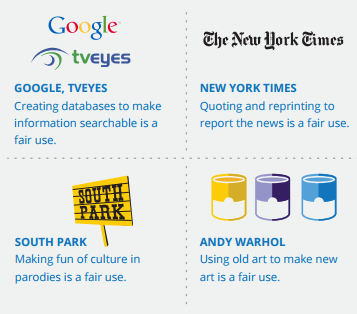8.5: Fair Use
- Page ID
- 86819
Fair Use

What about photos of copyrighted items?
If you take a photograph of a copyrighted item, this can sometimes count as reproducing the item and is a violation of copyright. However, there are some cases when it is okay – read this document from the World Intellectual Property Organization to learn more.
What is “Fair Use”?
According the U.S. Copyright Office’s factsheet on Fair Use, the rights of copyright owners are subject to limitations. One of the more important limitations is the doctrine of “Fair Use.”
The doctrine of Fair Use allows users of copyrighted works to reproduce and reuse copyrighted works in ways that are considered fair–such as criticism, comment, news reporting, teaching, scholarship, and research.
The Four Factors
Section 107 of U.S. Copyright Law provides four factors to consider when considering whether the use of copyrighted works is a fair one:
- The purpose and character of the use, including whether such use is of commercial nature or is for nonprofit educational purposes
- The nature of the copyrighted work (e.g., whether it is factual or creative in nature)
- The amount and substantiality of the portion used in relation to the copyrighted work as a whole
- The effect of the use upon the potential market for or value of the copyrighted work
Tools to Determine Fair Use
-
This interactive online tool from the University of Minnesota provides a checklist of relevant information about the four factors of Fair Use. At the end, a report can be generated for your use. This is by far our favorite Fair Use tool at the Pitt libraries!
-
This is a printable checklist about the four factors of Fair Use. This document is very useful for classroom settings.
-
An interactive tool designed to help users think through Fair Use arguments. More free-form than the University of Minnesota “Thinking Through Fair Use” tool. Relies on prior knowledge of fair use.
Fair Use Examples


One important note…
The U.S. Copyright Office’s factsheet on “Fair Use” notes that
The distinction between what is fair use and what is infringement in a particular case will not always be clear or easily defined. There is no specific number of words, lines or notes that may safely be taken without permission. [Emphasis added] Acknowledging the source of the copyrighted material does not substitute for obtaining permission.
- Fair Use. Authored by: John Barnett, Revision and Adaptation: Lauren B. Collister. Located at: http://pitt.libguides.com/copyright/fairuse. License: CC BY: Attribution

